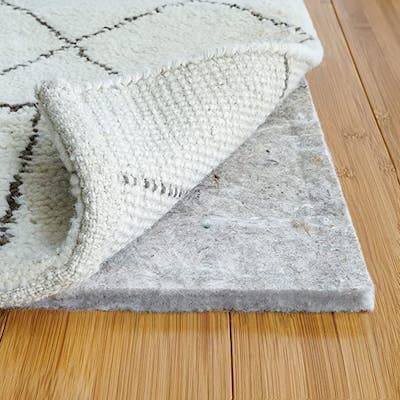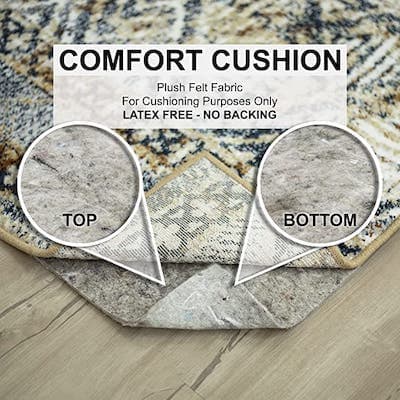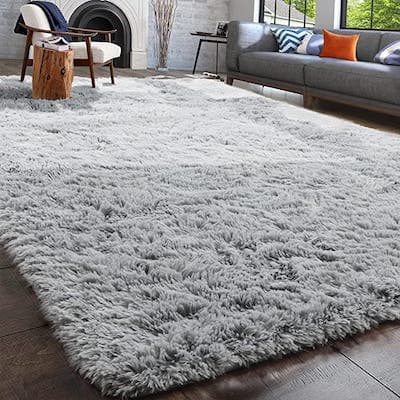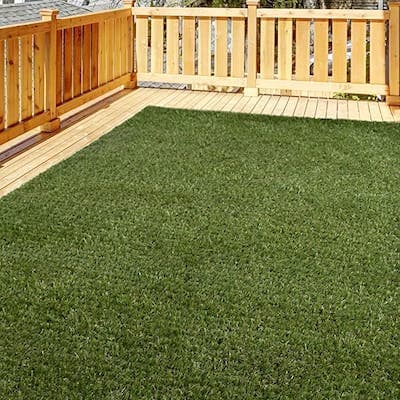Rug Size Guide
After you decide where you want to place your rug, your next question is:
What size should the rug be?
To answer this question, you need to know two things:
- What room will it be in?
- What is the rug’s purpose? (design centerpiece for the room, comfort underfoot, frame furniture, etc)
This article will give you the exact rug size you need, and in cases where that’s not possible, give you the guidelines you need to follow to determine your perfect customized rug size.
Of course, if you still have questions, let me know in the comments below.
Let’s start with what rug size options you have:
What sizes do rugs come in?
There are 3 basic rug sizes you’ll find:
- rectangle: this is the most common rug size. the length is longer than the width, but they are not as long as runners. these are often used for centerpieces, under or in front of furniture, or in entryways for cleaning shoes. common sizes: 3×5, 4×6, 5×8, 8×10, 9×12
- runners: these are also rectangles but longer: the length is often 2-4 times longer than the width. these are mostly used for hallways or long entryways. common sizes: vary but often 2-3ft width and 4-16 feet long
- square or round: these have the same size edges (or diameter in the case of round/circle rugs). you’ll usually find these under furniture, especially tables. common sizes: 5, 6 ,7 , 8, 9, and 10-foot sides or diameter

Captain’s don’t feel stuck! The common sizes listed aren’t the only rugs available, just the most commonly seen in stores. Also, you can buy customized rug sizes if you know exact dimensions you need. More on what dimensions you need below.
So what size is best for you?
The rug size you want is based on the room you’re putting it in, as well as the placement of the rug. Once you have those decided, these guidelines will help you choose your rug size:
Living room
When you are picking a rug size for your living room, the first thing you will need to decide is where you want the rug to go. There are three general placements: under a sofa or furniture, in front of your sofa, or in the middle of a large living room as a centerpiece.
If the rug will go in front of your furniture, you usually want a medium or smaller sized rug: 4×6 or 5×8 might work. This one varies more than the others because the gaps between your furniture vary. Most of the time you’ll want a 6 to 18″ border (no rug) from your couch and any other surrounding furniture.
If you want a center rug for a medium to large living room OR would like the rug to go underneath your sofa/furniture, you’ll probably want to go with a bigger rug: 9×12 or even bigger. This will allow it to fill some of your living room and still leave a border. It will also allow it to cover under your couch by giving a nice border extending past the couch.
If you want to frame the area under your sofa, the best way is to measure your sofa and then add 6″ to 18″. If you go with 6″, there won’t be much rug showing, just a small outline. If you go with 18″, it will be a little bit more comfortable border that you can even rest your feet on.
Dining room
Dining room rugs are traditionally placed under the table to give your feet a comfortable resting place while you eat. Therefore, the size of your dining room set will have a direct impact on the size of your rug.
The best way to measure the minimum size rug for your dining room is:
- Pull out a chair on each side as if someone were sitting in it.
- Take a tape measure and measure to measure the length and width of both sides. To do this, you will measure from the back of one chair to the back of the chair across from it.
- Add 12″ to each side.
This gives you a minimum size. In many cases, I would add 36″ more inches to give more room between the edge of the rug and the chairs. And really, you can’t add too much as long as you leave a 18″ border between your dining room walls.
Don’t want to measure? Here is a good guess of the rug size you’ll need by the number of chairs at the table:
- 6-seat table: 8×10
- 8-seat table: 9×12
- 10-seat table: 10×14
- Round table: 7-8 feet across

Captain’s design tip! Most design experts recommend you use a round rug under a round table. If this is the case for you, the instructions above apply with the exception there is only one length (the diameter) of the circle. In other words, use the exact same steps above but you only have to pull two chairs out from across the table, and measure that distance.
Bedroom
In the bedroom, there are two common things people want with rugs:
A rug to frame their bed by going under it, or a rug at the end of the bed.
Let’s start with framing the bed. Here is the rug size you will need based on your bed size:
| Bed Size | Rug Size |
|---|---|
| King | 9′ x 12′ |
| Queen | 8′ x 10′ |
These rug sizes give you a few feet on the sides of your bed, which is usually what you’ll want. It gives a border but doesn’t overcrowd your room. Sometimes, you may have the bed butting up again a side wall. In this case, you may not need your rug as wide. For reference, both king and queen beds are 6′ 8″ long. The width is where they differ: king beds are 6′ and queen beds are 5′.
Smaller or guest bedrooms may not need a full-sized area rug underneath the bed, but you may still want a rug there for its look and comfort. A 4×6 rug or runner placed alongside the bed adds a nice accent piece and will fit neatly into a more limited space.
Hallway
A hallway is a good example of a room without furniture. Instead of bordering the rug against the furniture, you will border it against the walls.
Runners come in several standard sizes. Most range from 6 feet up to 12 feet. A good rule of thumb is the runner should extend for about 75 percent of the hallway, with a short stretch of flooring at the start and end. You can also combine two runners with a six-inch gap between them.
Runners are easy to customize. Many carpet companies will keep runners on a roller and you simply specify how long you need it to be.
Captain’s parting words!
Rug size is a subjective art, but hopefully, these general guidelines help.
Much of it depends on where you’re putting the rug. Our rug placement guide can help you with that.
And also remember: if you can’t find the rug size you like, there are rug stores where you can order custom sizes. Or maybe even better, you can make your own rug pretty easily.
Any questions or thoughts on area rug sizing? Let me know in the comments below.
 |
 |
 |
 |
 |
|---|---|---|---|---|
| RUGPADUSA Cushioning Rug Pad | Peel & Stick Carpet Tiles (12 sf) | Mohawk Home Rug Pad | PAGISOFE Fluffy Area Rug | Faux Thick Realistic Grass Mats & Rugs |
| 4.5 18500+ ratings |
4.7 1100+ ratings |
4.5 12500+ ratings |
4.3 2000+ ratings |
4.5 1800+ ratings |
| $25 - $100 | $10 - $25 | $50 - $125 | $25 - $75 | $50 - $150 |


I’m having difficulty with figuring out rug placement and could really use some help. I have a room roughly 23’x11′ It is split down the center with the front door entrance and the entrance to the kitchen on the other side, creating two separate spaces about 11’x11′. My dog lays in the area in the center between the doorways. The living areas make up the living room and dining room. Any ideas on how to incorporate area rugs so there is one down the center for my dog? Envisioning a runner and two square or rectangular rugs seems like the space would be too chopped up. So would this look nice and just do smaller rugs in the living and dining spaces. Would it look off if I have a rug under the dining table but not under the couch and chair? I have open space between the living room furniture measuring 6’x7′. The couch and chair are at a right angle and the tv cabinet is across from the couch, to the far end. I bought a small dining table for my small house. It measures 50”x32”. Any guidance is greatly appreciated.
I want to put a rug in my office. I have a rectangle desk and 2 accent chairs for a small conversation area with clients.
nice post
Thank you… glad it helped!